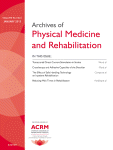
SHOULDER & ELBOW
Dextrose prolotherapy versus saline injections for rotator cuff tendinopathy
This report has been verified
by one or more authors of the
original publication.
Arch Phys Med Rehabil. 2016 Jan;97(1):17-25.
73 patients with rotator cuff tendinopathy were randomized to one of three study treatment groups: (1) hypertonic dextrose prolotherapy injection directly to affected entheses, (2) saline injection directly to affected entheses, or (3) saline injection superficial to affected entheses. The purpose of this study was to investigate the clinical benefits of dextrose prolotherapy when compared to control groups by observing improved patient-reported pain scores, patient satisfaction scores, and ultrasound grading of regenerative effect. Results demonstrated that dextrose entheses injection resulted in significantly improved outcome scores when compared to superficial saline injection, but showed comparable scores with saline entheses injection.
Unlock the full ACE Report
You have access to {0} free articles per month.Click below to unlock and view this {1}
Unlock NowCritical appraisals of the latest, high-impact randomized controlled trials and systematic reviews in orthopaedics
Access to OrthoEvidence podcast content, including collaborations with the Journal of Bone and Joint Surgery, interviews with internationally recognized surgeons, and roundtable discussions on orthopaedic news and topics
Subscription to The Pulse, a twice-weekly evidence-based newsletter designed to help you make better clinical decisions
Exclusive access to original content articles, including in-house systematic reviews, and articles on health research methods and hot orthopaedic topics
Or upgrade today and gain access to all OrthoEvidence content for just $1.99 per week.
Already have an account? Log in


Subscribe to "The Pulse"
Evidence-Based Orthopaedics direct to your inbox.
{0} of {1} free articles
Become an OrthoEvidence Premium Member. Expand your perspective with high-quality evidence.
Upgrade Now













































































